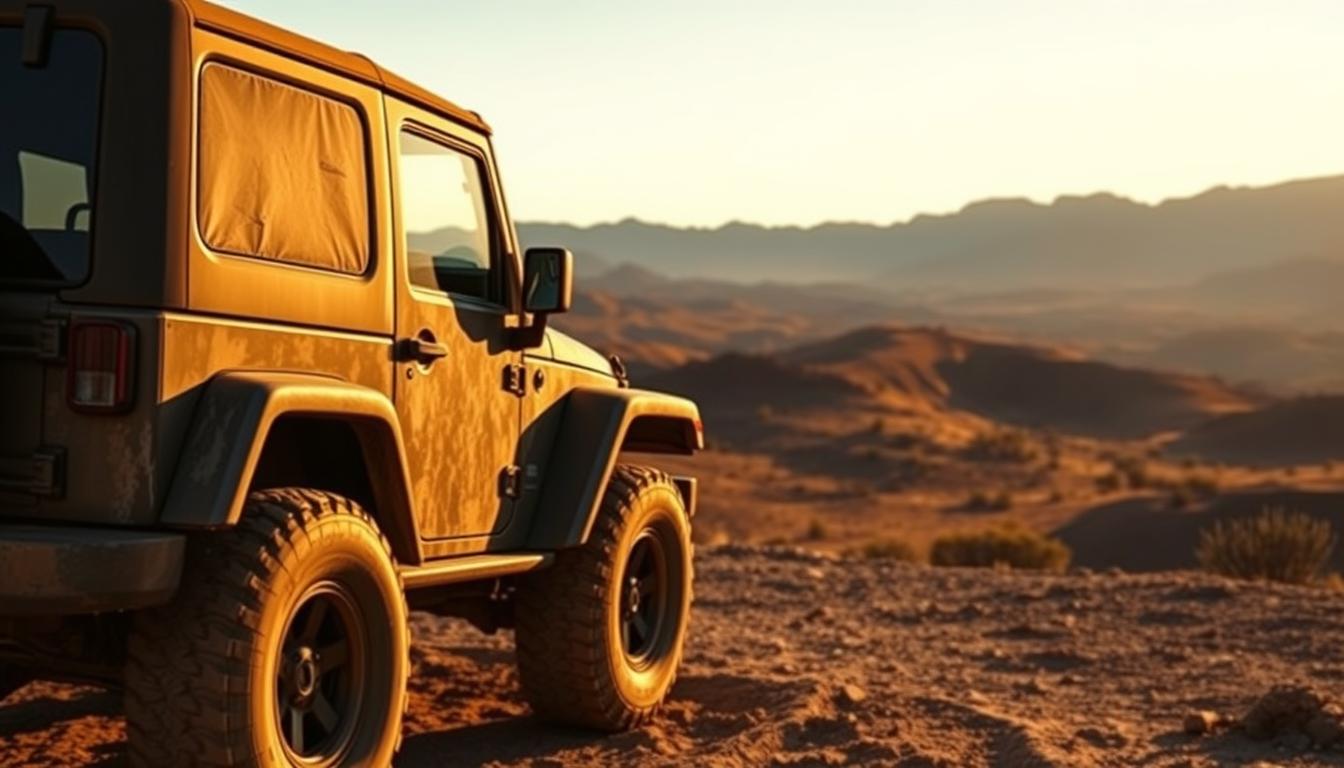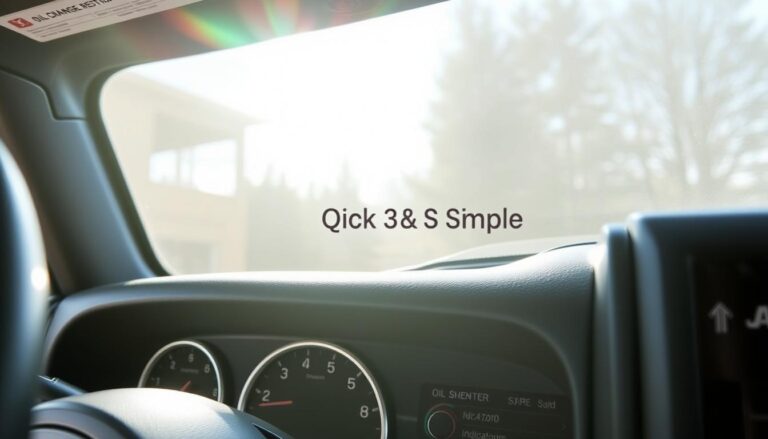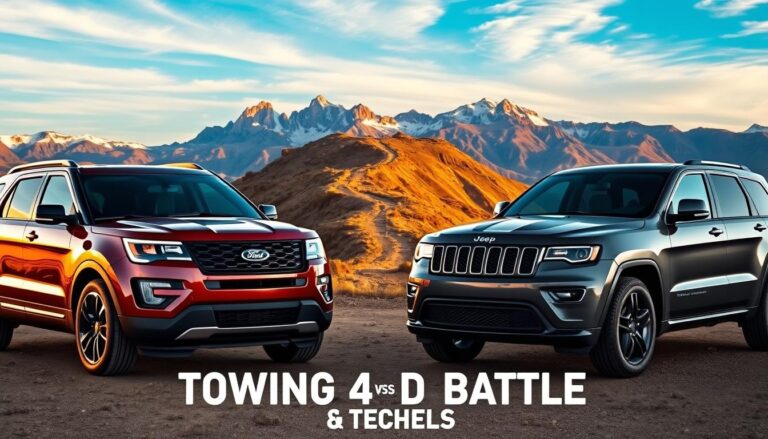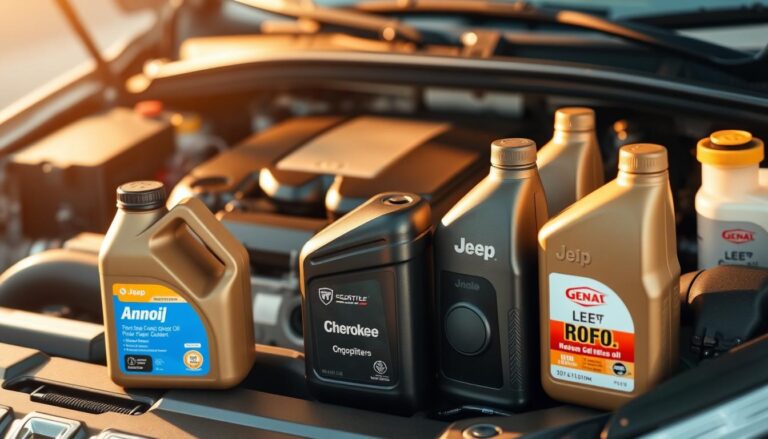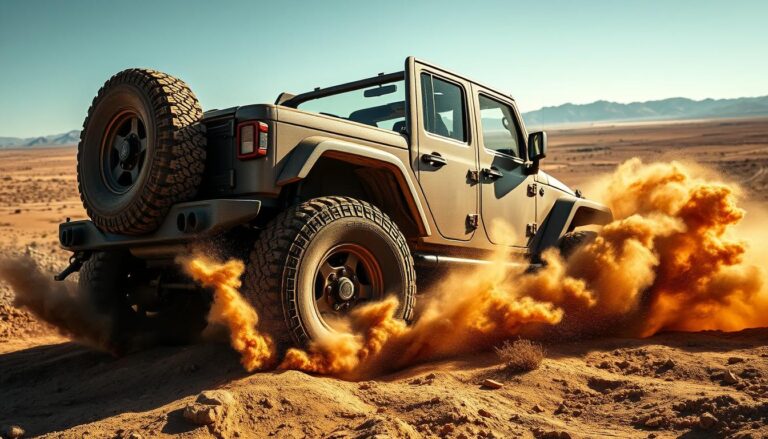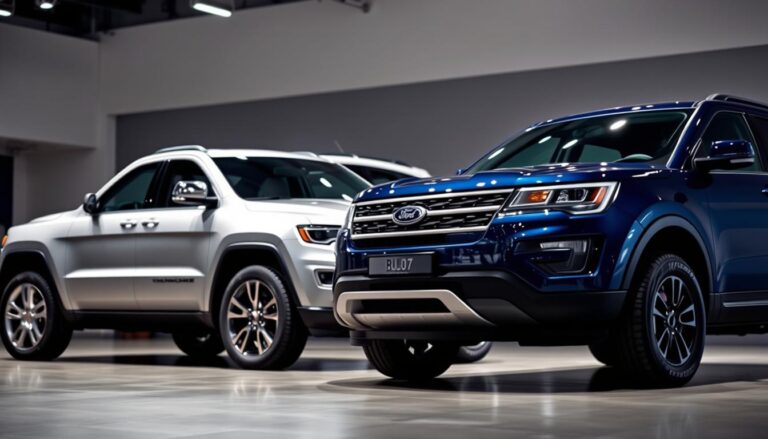Jeep Wrangler Mileage: What to Expect for the Long Haul
When thinking about a tough and dependable vehicle, the Jeep Wrangler often comes to mind first. This iconic SUV is famous for its Jeep Wrangler longevity and lasting power. It’s built for challenging adventures and everyday use, loved by both thrill-seekers and daily drivers.
The Jeep Wrangler lifespan shows its history of strong performance and mechanical dependability. From the earliest CJ to the newest JL series, every model is made to last. It can handle rocky paths and highways alike, making it a long-lasting investment for its owners.
This guide will explore why the Jeep Wrangler durability is so remarkable. We’ll look at what owners say and dive into the technical side too. By the end, you’ll understand why the Jeep Wrangler continues to be a top SUV choice for mileage and reliability.
Overview of Jeep Wrangler Durability
Jeep Wrangler durability is famous for good reason. We’ll look into its toughness – from its track record to how it’s built and what drivers say. All to show why it keeps breaking Jeep Wrangler mileage records.
Historical Performance
The Jeep Wrangler has a long history of lasting a long time. For years, these vehicles have proven they can handle tough situations. They’ve racked up many high mileage records, proving their long-lasting design and strong engineering.
Building Quality
The Jeep Wrangler’s top-notch build quality tells you it’s made to last. It uses sturdy materials and is made for rough roads. Things like its strong frame, tough steel body, and advanced suspension help it set incredible Jeep Wrangler mileage records.
User Testimonials
What Wrangler owners have to say proves its durability too. Many talk about how their Wranglers, with lots of miles, still run great. These stories show that the Wrangler can be trusted for a long time.
Looking at its history, how it’s made, and owner stories, it’s clear why the Wrangler is so trusted by those who want a dependable car.
Factors Affecting Jeep Wrangler Mileage
To get the best from your Jeep Wrangler, know what affects its mileage. Things like driving styles and how well you maintain it matter a lot. They decide how many miles your Wrangler will last. We will look at what can make your Jeep’s engine go the distance.
Driving Conditions
How and where you drive changes your Jeep’s mileage. Rough, off-road adventures work your vehicle harder, which might lower its mileage. City drives, with lots of stopping and starting, also use more fuel. You can adjust how you drive based on these conditions to help your Jeep perform better.
Maintenance Practices
Keeping your Jeep in top shape is key to its longevity. Regular check-ups and fixing problems right away keep it running well. Doing things like changing the oil, rotating tires, and checking the brakes will really help. These steps will make your Jeep last longer.
Engine Types
The kind of engine your Jeep has also plays a role in its mileage. Different engines have different strengths, affecting how much fuel they use and how long they last. Let’s compare a few Jeep Wrangler engines and see how they stack up:
| Engine Type | Fuel Efficiency (MPG) | Average Mileage |
|---|---|---|
| 3.6L V6 Pentastar | 17 City / 25 Highway | 250,000+ miles |
| 2.0L Turbocharged I4 | 23 City / 25 Highway | 200,000+ miles |
| 3.0L EcoDiesel V6 | 22 City / 29 Highway | 300,000+ miles |
Knowing these tips helps Jeep owners make smart choices. This way, they keep their vehicles reliable for a long time.
Average Mileage Expectations for Jeep Wranglers
Knowing how long Jeep Wranglers can go is key for potential buyers and owners. Jeep Wrangler mileage varies due to driving habits, maintenance, and engine types. Let’s look at the numbers for a better idea.
Manufacturer data, aftermarket reports, and user feedback reveal a Jeep Wrangler lasts 200,000 to 300,000 miles with good care. This range shows the vehicle’s strong build and lasting appeal.
To give a detailed picture, here are figures from trusted auto sources:
| Source | Mileage Range |
|---|---|
| Manufacturer Data | 200,000 – 250,000 miles |
| Aftermarket Reports | 220,000 – 280,000 miles |
| User Surveys | 240,000 – 300,000 miles |
Some owners have even gone past 300,000 miles, thanks to careful maintenance and driving. So, if you’re considering a Jeep Wrangler, you can expect it to last a long time.
In short, Jeep Wranglers are known for high mileage. They are a sturdy and reliable option for those seeking a vehicle that endures.
High Mileage Jeep Wranglers: Success Stories
Many Jeep owners have proven their Wranglers can go way past normal mileage. These vehicles show how sturdy and dependable they are. High mileage Jeeps stand as proof of what this famed SUV can endure.
User Experiences
Jeep fans love sharing their high-mileage stories. It’s not rare to hear about Jeeps going over 200,000 miles. This is thanks to good care and the Wrangler’s strong build. One person mentioned their 1999 model reached 300,000 miles with only a few fixes needed. This shows just how far a Wrangler can go.
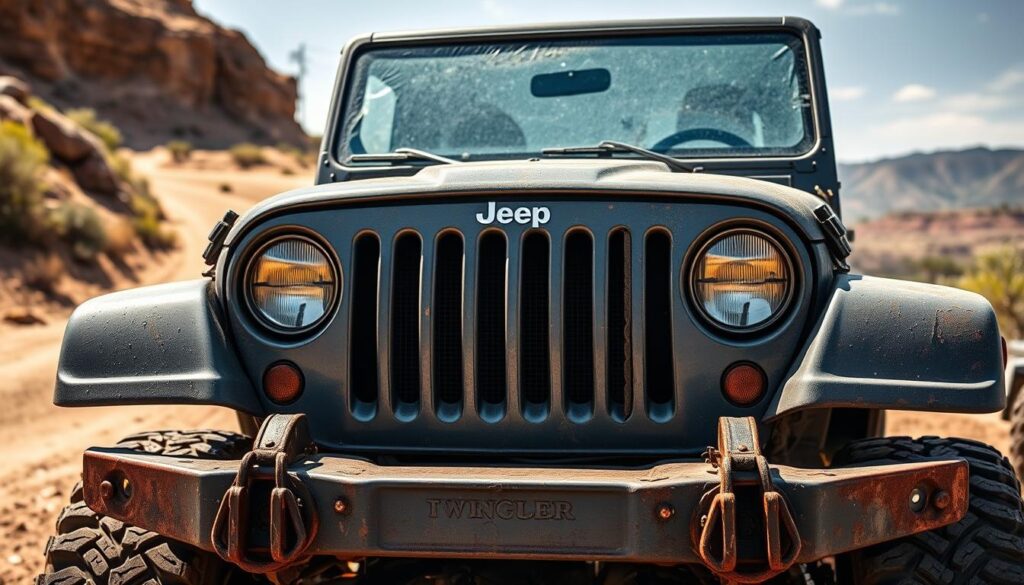
Common Maintenance Tips
To hit high mileage, you need to look after your Wrangler. Here’s how long-term owners keep their Jeeps running:
- Regular Oil Changes: Change oil every 3,000 to 5,000 miles for a smooth engine.
- Tire Rotation: Rotate tires every 6,000 miles to wear them down evenly.
- Brake Inspections: Check and replace brake pads often, especially if you go off-road.
- Fluid Levels: Keep an eye on and fill up coolant, transmission, and brake fluid when needed.
- Use Quality Parts: Choose OEM or top-quality aftermarket parts for longer life.
Challenges Faced
Reaching high mileage can bring problems. Owners might face:
- Rust and Corrosion: Older models or ones in bad weather might rust. Regular checks and treatments help.
- Engine Wear: Lots of miles can reduce performance. Keeping up with engine care and fixes helps.
- Electrical Problems: Old wiring can be troublesome. Fix electrical issues quickly for reliability.
Even with these issues, proper care can make a Jeep Wrangler last a long time.
Tips to Maximize Your Jeep Wrangler Lifespan
To ensure your Jeep Wrangler lasts long, adopt proper Jeep Wrangler maintenance practices. Here are some effective tips:
1. Scheduled Maintenance
It’s key to follow the maker’s service schedule closely. This means doing regular oil changes, brake checks, and rotating tires.
2. High-Quality Fluids
Choosing top-notch engine oil, transmission fluid, and coolant is vital for Jeep Wrangler’s health. Use fluids recommended for Jeep Wranglers.
3. Address Wear and Tear Promptly
Fix mechanical issues as soon as they appear. Ignoring small problems can lead to bigger, costlier issues and dangers.
4. Tire Care
Looking after your tires, such as monitoring pressure and alignment, boosts their lifespan. It also improves gas mileage and handling.
5. Protect from Rust
Preventing rust is critical for any car. Wash your Jeep, especially after off-roading or in salty conditions, to avoid rust and protect the underbody.
6. Off-Roading Practices
Jeep Wranglers are made for tough terrains, but treat them kindly. Don’t overdo it and check for damages after each off-road trip.
7. Keep It Clean
Keeping your Jeep clean inside and out maintains its looks and prevents damage to paint and seats.
By following these steps, you’ll not only look after your Jeep Wrangler but also enjoy its toughness and long life.
Jeep Wrangler Engine Life and Performance
When looking at Jeep Wrangler engine life, it’s key to think about the different engine types. Each one has its own set of performance numbers. These numbers help show how long the engine might last and how well it drives. Let’s explore these engine types and their performance below.
Engine Variants
The Jeep Wrangler has a variety of engine choices. Each one affects how long the engine lasts and how it performs. These include:
- 2.0L Turbocharged Inline-4
- 3.6L Pentastar V6
- 3.0L EcoDiesel V6
Every engine type brings something special. The 2.0L Turbocharged Inline-4 mixes power with fuel efficiency, perfect for both city and off-road driving. The 3.6L Pentastar V6 is known for reliable performance. And the 3.0L EcoDiesel V6 is great for fuel economy and strong torque.
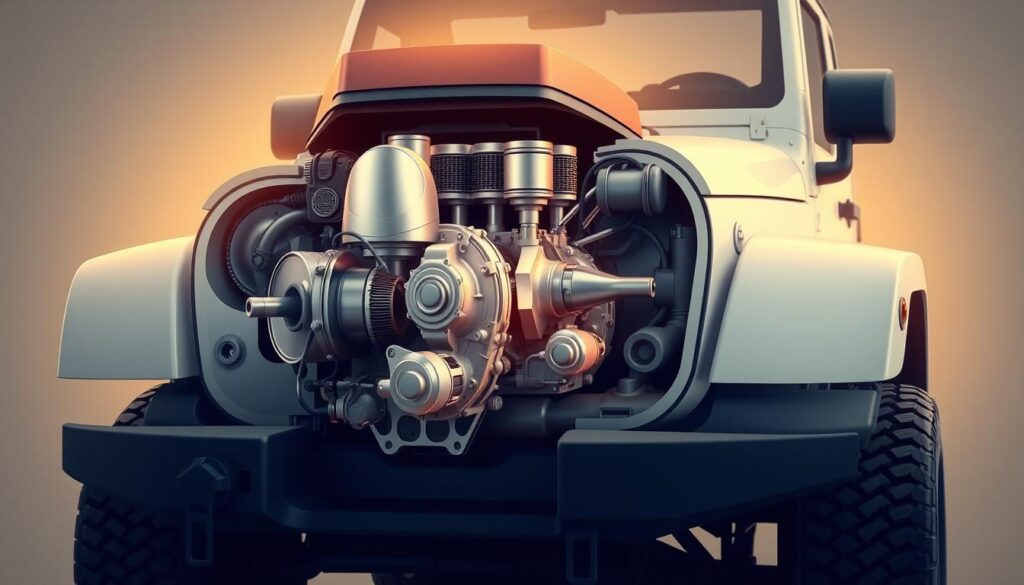
Performance Metrics
We’ll now look closer at the performance numbers for each engine type. These details help us understand their possible lifespan:
| Engine Type | Horsepower (HP) | Torque (lb-ft) | Fuel Efficiency (MPG) |
|---|---|---|---|
| 2.0L Turbocharged Inline-4 | 270 | 295 | 23 city / 25 highway |
| 3.6L Pentastar V6 | 285 | 260 | 20 city / 24 highway |
| 3.0L EcoDiesel V6 | 260 | 442 | 22 city / 29 highway |
The performance metrics of each engine are key to the Jeep Wrangler engine life. The 3.0L EcoDiesel V6, for example, might last longer due to its torque and fuel efficiency. This makes it great for long drives and tough off-road conditions. The 3.6L Pentastar V6 is a solid choice for its dependable performance in many situations.
Common Maintenance Practices for Jeep Wranglers
Keeping your Jeep Wrangler in top condition means it will last longer and perform better. Here are vital Jeep Wrangler maintenance practices every owner needs to do regularly:
- Regular Oil Changes: This step is key. Clean oil keeps engine parts running smoothly and maintains your Jeep’s performance.
- Fluid Replacements: It’s not just engine oil that needs attention. Make sure to check and change brake, coolant, and transmission fluids as needed.
- Brake Inspections: Checking your brakes often ensures your safety. It also keeps your Wrangler ready for any terrain.
- Tire Maintenance: Good tire care involves rotating them and checking their tread depth and pressure.
- Battery Care: Clean battery terminals often and test the battery to prevent it from failing unexpectedly.
- Belt and Hose Inspections: Check belts and hoses for damage often. Changing them before they break can avoid bigger problems.
- Air Filter Replacement: A clean air filter is crucial for good fuel efficiency and engine power.
| Maintenance Task | Frequency |
|---|---|
| Oil Change | Every 3,000 – 5,000 miles |
| Brake Inspection | Every 10,000 miles |
| Tire Rotation | Every 6,000 – 8,000 miles |
| Battery Check | Annually |
| Fluid Check | Every 5,000 – 7,000 miles |
| Belt and Hose Check | Every 50,000 miles |
| Air Filter Replacement | Every 12,000 miles |
By sticking to these Jeep Wrangler maintenance practices, your Jeep will stay dependable for any adventure. Doing regular maintenance avoids expensive repairs and keeps your Wrangler lasting longer. This makes your trips both safe and fun.
How Off-Roading Affects Jeep Wrangler Longevity
Going off-roading in your Jeep Wrangler is thrilling. Yet, it’s vital to know how it affects your Jeep’s life. Off-roading puts a lot of stress on parts of the vehicle. This can make them wear out faster. Knowing the challenges helps Jeep owners keep their vehicles running well for a longer time.
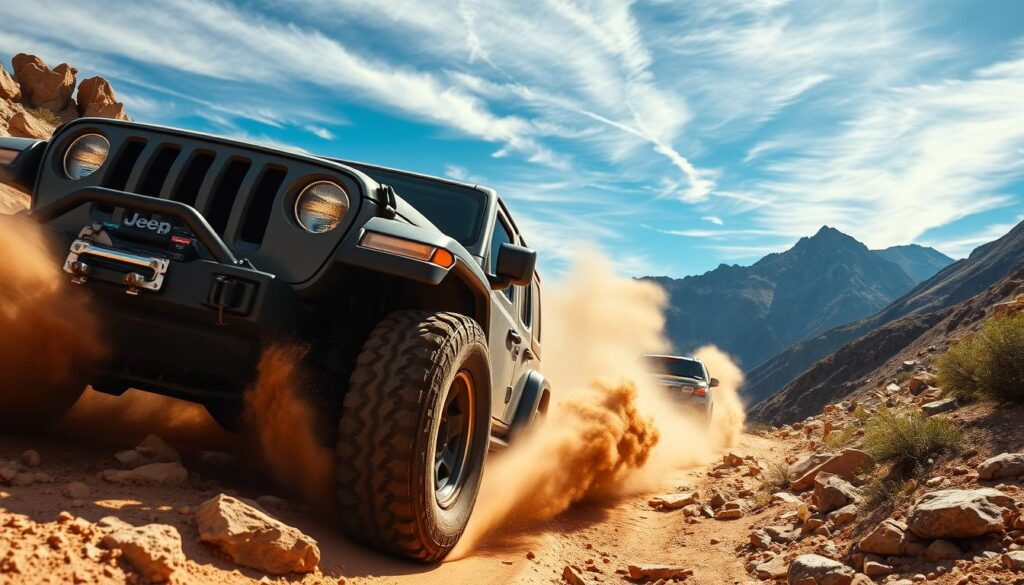
Rough ground puts extra strain on the suspension, tires, and undercarriage. The Jeep Wrangler is built tough, so it can handle a lot. However, if you go off-roading a lot, you need to take good care of it.
Here are some key maintenance tips:
- Check the suspension system regularly for any damage
- Keep an eye on your tires and rotate them often
- Wash off mud and debris to protect important parts
- Look under the Jeep for rust or other damage sometimes
By following these maintenance steps, your Jeep Wrangler can last longer, even if you off-road often. This way, your Wrangler stays dependable and works its best for years. It also keeps its value and usefulness.
The Role of Regular Maintenance in Increasing Mileage
For your Jeep Wrangler to perform its best and reach its highest mileage, following a regular maintenance schedule is key. Timely and proper care greatly improves your vehicle’s lifespan and reliability.
Service Intervals
Sticking to the recommended Jeep Wrangler service intervals is a big part of maintenance. These intervals are made by the manufacturer to fix parts before they turn into big problems.
Let’s dive into some usual service intervals:
| Service Interval | Maintenance Tasks |
|---|---|
| Every 5,000 miles | Oil change, tire rotation, and brake inspection |
| Every 10,000 miles | Replace air filter, inspect cooling system, and inspect exhaust |
| Every 30,000 miles | Transmission fluid replacement, full brake system inspection, and battery check |
| Every 60,000 miles | Replace spark plugs, inspect suspension, and check belts and hoses |
Component Checks
Regularly looking over critical parts also helps keep your Jeep Wrangler in good shape. Keeping an eye on things like brakes, suspension, and transmission fluids is necessary for regular maintenance.
By keeping up with these service times and checks, you ensure your Wrangler stays strong. Plus, it will keep running great and getting excellent mileage for years.
Signs Your Jeep Wrangler Needs Immediate Attention
Having a Jeep Wrangler means you love adventure. But, you need to keep an eye on its performance and safety. Here are signs that show your Jeep Wrangler needs immediate attention:
Unusual Noises: Hearing persistent clunking, grinding, or squealing sounds can mean big problems. These noises might tell you about transmission issues or brake failures.
Warning Lights: Don’t ignore it when dashboard warning lights come on. Like the check engine light, they often hint at problems that need quick fixes.
Handling Discrepancies: If driving your Jeep Wrangler feels off, or it drifts on the road, it might have suspension or alignment issues. You should get it checked immediately.
Fluid Leaks: Seeing any oil, coolant, or other fluid leaks? These can cause serious engine damage or overheating. It’s important to fix leaks fast.
Overheating: An engine that overheats could get really damaged quickly. Watch the gauges and look out for steam to catch this problem early.
Braking Issues: Brakes that feel spongy or don’t respond well are a red flag. It’s vital to inspect brakes regularly to stay safe.
Vibrations or Shaking: Feeling weird vibrations or shaking, especially when driving fast? This might mean problems with your tires or the drivetrain.
Paying attention to these signs and following good maintenance tips will keep your Jeep Wrangler in great shape. Always look at your owner’s manual for upkeep schedules. And see a mechanic if something seems off.
How Many Miles Can Jeep Wranglers Last?
People often wonder about the lifespan of Jeep Wranglers. They want to know how far these vehicles can go. Usually, with good care, a Jeep Wrangler can go over 200,000 miles.
Realistic Expectations
The lifespan of a Jeep Wrangler varies. But with proper maintenance, reaching 250,000 miles is quite common. Some owners have even pushed past 300,000 miles.
Factors That Influence Longevity
Many things affect how long a Jeep Wrangler will last. These include:
- Maintenance Practices: Sticking to a regular service schedule helps a lot. This means changing oil regularly, rotating tires, and fixing issues promptly.
- Driving Conditions: Where you drive matters. Off-roading is hard on the vehicle but also part of the fun.
- Engine Types: Different engines can last longer. For instance, the 3.6L Pentastar V6 engine is known for its reliability.
Comparisons with Competitors
When comparing longevity, the Jeep Wrangler stands out. It’s up against others like the Toyota 4Runner and Ford Bronco. However, its durability and support from a loving community often make it the top choice for those who love adventure.
In short, the key to a Jeep Wrangler’s long life includes good maintenance, considerate driving, and its built-to-last nature. This sets the stage for Jeep Wrangler owners to have high hopes for their vehicle’s longevity.
Conclusion
The Jeep Wrangler is a symbol of strong and lasting design. It’s famous for its powerful performance and strong build. We’ve looked closely at what makes the Jeep Wrangler last so long. This includes its history, build quality, maintenance, and how it’s driven.
To make a Jeep Wrangler last longer, follow the maintenance tips. This means regular checks and services. Also, think about the engine type and how much off-roading you do. These choices affect how long your Wrangler will last.
If you own or are thinking of buying a Jeep Wrangler, be clear about its mileage and upkeep. Taking the right steps can help you keep your Wrangler for many adventures. This guide’s advice will help you get the most out of this legendary vehicle for many years.

